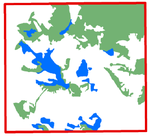Abstract
The representation of a land cover type (i.e. habitat) within an area is often used as an explanatory variable in species distribution models. However, it is possible that a simple binary presence/absence of the suitable habitat might be the most important determinant of the presence/absence of some species and, thus, be a better predictor of species occurrence than the continuous parameter (area).
We hypothesize that the binary predictor is more suitable for relatively rare habitats (e.g. wetlands) while for common habitats (e.g. forests) the amount of the focal habitat is a better predictor. We used the Third Atlas of Breeding Birds in the Czech Republic as the source of species distribution data and CORINE Land Cover inventory as the source of the landcover information. To test our hypothesis, we fitted generalized linear models of 32 water and 32 forest bird species.
Our results show that for water bird species, models using binary predictors (presence/absence of the habitat) performed better than models with continuous predictors (i.e. the amount of the habitat); for forest species, however, we observed the opposite. Thus, future studies using habitats as predictors of species occurrences should consider the prevalence of the habitat in the landscape, and the biological role of the habitat type in the particular species’ life history. In addition, performing a preliminary comparison of the performance of the binary and continuous versions of habitat predictors (e.g. using information criteria) prior to modelling, during variable selection, can be beneficial.
These are simple steps that will improve explanatory and predictive performance of models of species distributions in biogeography, community ecology, macroecology and ecological conservation.
